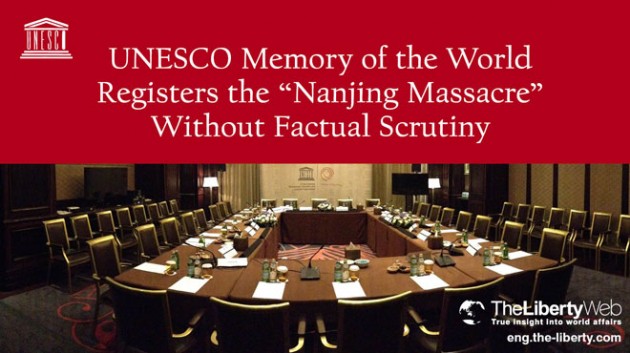UNESCO Memory of the World Registers the “Nanjing Massacre” Without Factual Scrutiny
The Paris-based United Nations Educational, Scientific, and Cultural Organization (UNESCO) announced at night on October 9th local time (before dawn on the 10th Japan time) that it has agreed to inscribe the “Nanjing Massacre” nomination that China had applied for registration in its Memory of the World register (MOW). China had also nominated “comfort women” files, but they were not registered in the list at this time.
Responding to the inscription, the Foreign Press Secretary, Yasuhisa Kawamura, issued a statement, saying, “As a responsible member of UNESCO, the Japanese government will seek a reform of this important project, so that it will not be used politically.” According to government officials, the government is considering freezing funding to UNESCO (the October 10th issue of the Sankei Shinbun).
There is an undeniable sense that the Japanese government began making moves after UNESCO’S announcement. The details about how the government has protested against China’s application so far have been unclear. The Abe administration has been considered to be positive about correcting distorted perceptions of history, but how did Prime Minister Shinzo Abe perceive this “defeat” in the full-scale battle over the historical issues? In retrospect, however, this diplomatic defeat was predictable to some extent.
What Are the Contents of the “Documents of the Nanjing Massacre”?
Since China’s nomination of the “Nanjing Massacre” documents became clear in June of last year, the Japanese government has not shown its intention to protest strongly against China’s move.
On the contrary, the Happiness Realization Party (Party Leader: Ryoko Shaku) immediately took action. In July of last year, it staged a protest march with 1,700 people in Tokyo. This year, it obtained details about the documents that China had submitted to UNESCO, and it immediately went about writing rebuttal documents in English. A representative of the HRP visited UNESO’s headquarters in Paris and submitted four rebuttal reports and also sent them to the International Advisory Committee (IAC), which conducts the final deliberations, calling on UNESCO to reject China’s application of the documents about the fabricated history. More than 100 Japanese and foreign intellectuals agreed with the HRP’s rebuttal documents.
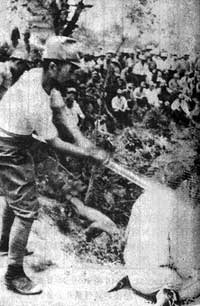
One of 16 photos that allegedly show a Japanese soldier beheading a Chinese man. However, Professor Higashinakano has pointed out, “This is a Chinese fabrication.” While the Nanjing Massacre allegedly happened during the winter, the Japanese soldiers are lightly dressed, and some even have their sleeves rolled up. The shoes of the man in front of the picture aren’t military attire either.
The registered “Nanjing Massacre” documents included a photo that allegedly shows a Japanese soldier beheading a Chinese man, the “Magee Film”, “Tsen Shui-Fang’s diary” that recorded atrocities by the Japanese Army in Nanjing, and other items.
However, none of those documents have proven that the Japanese Army did these crimes. Tsen’s diary, which is known as China’s “The Diary of Anne Frank”, is nothing but a list of hearsay. The documents that China submitted to UNESCO have not proven that the “Nanjing Massacre” actually happened. (Refer to the article “A False Memory: Nominating the “Nanjing Massacre” to the UNESCO Memory of the World Program on The Liberty Web)
Moreover, the investigation that the HRP conducted found that the “Nanjing Massacre” documents included additional materials. There were court documents on Lieutenant General Toshio Tani, the commanding officer of the 6th Division, who the Chinese Nationalist Party tried at the Nanjing War Crimes Tribunal after the war. Tani was executed as the mastermind behind the killing of more than 300,000 Chinese civilians.
When examined more closely, it turned out that the 6th Division had stayed in Nanjing only for a few days, and that Lieutenant General Tani had also stayed only for a week or so. Therefore, it was physically impossible for the Japanese Army to perpetrate the massacre, which proves that Tani was falsely charged.
Did the HRP’s Rebuttal Prevent the “Comfort Women” Files from Being Registered?
UNESCO passed up the registration of the materials related to the so-called comfort women. There are some materials that seemed to have had a big influence on this decision. One of them was a picture of the military brothel in Yang Jia Zhai that Mr. Tetsuo Aso, a military officer of the Japanese Army, took in Shanghai in February of 1938. China claimed that the picture provided evidence that the comfort women were sex slaves and that it owned the copyright to this picture.
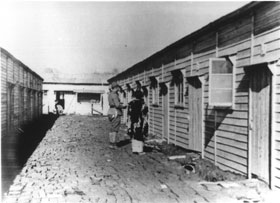
A brothel that the Japanese Army operated in Shanghai. According to the Relationship between “Comfort Women and Medical Treatment” written by Kuni Amako and Tetsuo Aso, the picture was taken by Mr. Aso on February 7th in 1938. China has not indicated the source of the picture.
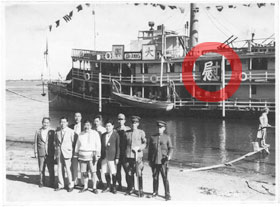
China explained the ship in the picture as “a ship that transported comfort women”. But it is not clear who took the picture, and when and where it was taken.
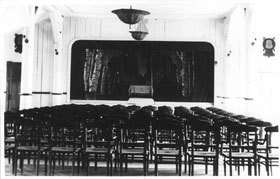
China introduced this picture as a brothel in Heilongjiang. But it is not clear who took the picture and when, and it does not provide sufficient evidence that it was actually a brothel.
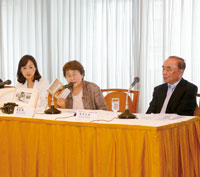
On June 10th, the leader of the HRP, Shaku, Ms. Amako, and Mr. Hiromichi Moteki attended a press conference at the Foreign Correspondent’s Club of Japan, claiming that China had submitted false materials to UNESCO.
However, Ms. Kuni Amako, Mr. Aso’s daughter, argued against China’s claim by saying that the comfort women were not sex slaves. She said that she did not allow China to use her father’s photo, which revealed that China had recommended the photo to UNESCO without her permission. Ms. Amako submitted a written opinion to UNESCO with the HRP’s second rebuttal document. (詳細は、2015年6月号記事「判明! 中国が出した「慰安婦」資料 これこそ「強制連行」「性奴隷」を否定する証拠だ」)
Furthermore, Ms. Amako attended a press conference that the HRP held in Tokyo in June of this year and protested against China’s application along with the party leader Shaku. The critic, Hiromichi Moteki, also attended the press conference. (Refer to the article “HRP Held a Press Conference to Protest China’s Nomination to UNESCO” on The Liberty Web)
Although it is not known whether the series of rebuttals made by the HRP worked, UNESCO pointed out inadequacies in the documents that China had submitted earlier. In response to this, China applied to register new documents by the end of June. The HRP immediately made a rebuttal statement. (Refer to the article “Is UNESCO Politicized? MOW May Kill UNESCO’s Validation on The Liberty Web)
As a result of the protest activities of the HRP, the “comfort women” documents were not added in the registration at this time.
The Japanese Government Acknowledges the “Nanjing Massacre” and the “Forcible Recruitment of Comfort Women”
On the other hand, the Japanese government has not effectively argued against China’s claim. This is no wonder, since the government’s stance on the “Nanjing Massacre” is as follows:
The Government of Japan believes that it cannot be denied that following the entrance of the Japanese Army into Nanjing in 1937, the killing of a large number of noncombatants, looting, and other acts occurred. However, there are numerous theories as to the actual number of victims, and the Government of Japan believes it is difficult to determine which the correct number is.
In terms of the “comfort women,” the Japanese government has maintained the basic stance of following the statement that the former Chief Cabinet Secretary Yohei Kono made.
In this way, the Japanese government believes that the Nanjing Massacre did happen, and follows the Kono statement that virtually acknowledged the forcible recruitment of women by the Japanese Army. How can the government argue against China’s claim in full-scale if it maintains this stance?
The Historical Truth Is that “There Was No Nanjing Massacre”
In the first place, there never was any massacre in Nanjing. This is the historical truth. As a basis for this assertion, the following points can be given.
- The population of Nanjing increased after the occupation by the Japanese Army.
- The leader of the Chinese Nationalist Party, Chiang Kai-shek, who fought the Japanese Army, held about 300 press conferences, but he never touched on the “massacre” in front of foreign reporters.
- An Australian journalist who published the world’s first book about the “Nanjing Massacre” was an agent working for the Chinese Nationalist Party.
- The figure of the buried corpses that the Tokyo Tribunal validated was found to be a fabrication after the war.
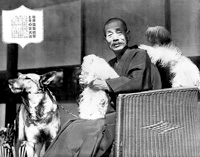
General Matsui was a dog lover. He took three abandoned dogs in Nanjing and named them Koa (left), Miika (center), and Yuriko (right).
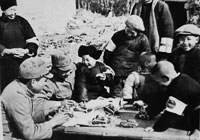
Children of Nanjing playing with toys with Japanese soldiers
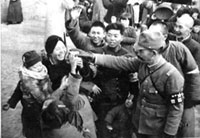
Nanjing women happily receiving milk from the Japanese Army
In view of these facts, the “Nanjing Massacre” is obviously Chinese political propaganda. Nonetheless, the “massacre”, which was fabricated history, has spread throughout the international community. Some members of UNESCO’s IAC might have gone into the selection process with a mistaken belief that the massacre had actually happened. And yet, the Japanese government’s protest against UNESCO and China was not based on the premise that “there was no massacre in Nanjing”. It went no further than criticizing China for using UNESCO for political purposes and pointing out inadequacies in its documents.
The Battle over Historical Issues Must Be Ended to Protect Our Children and Grandchildren
In August of this year, Prime Minister Abe issued a statement to commemorate the anniversary of the end of WW2 in which he said, “We must not let our children, grandchildren, and even further generations to come, who have had nothing to do with that war, be predestined to apologize.” The Japanese conservatives gave some positive evaluations to the statement, but we must seriously consider the fact that the statement has not prevented actual damage to the reputation of Japan.
South Korea is preparing for a registration of materials related to the “comfort women” jointly with six countries and regions like Taiwan and the Philippines. If things run smoothly, Japan will be facing a similar situation around this time in 2017. China and South Korea obviously have no intention of stopping their anti-Japanese diplomatic policies, so a situation like this will continue like an attack in waves. We must not let these countries hurt the national pride of Japan any more.
Once more, there were no such things as the “Nanjing Massacre” and the “forcible recruitment of comfort women as sex slaves”.
During WW2, our ancestors sacrificed their lives to protect the future of Japan. We, who live in the present, must protect the future for the sake of our children and grandchildren. Presenting a correct history to the international community will mark a major step toward this goal.
Related
- A False Memory: Nominating the "Nanjing Massacre" to the UNESCO Memory of the World Programme
- Call to Deny Inscription of the "Comfort Women" and the "Nanjing Massacre" to the UNESCO Memory of the World Program
- HRP Held a Press Conference to Protest China's Nomination to UNESCO
- Is UNESCO Politicized? MOW May Kill UNESCO's Validation

